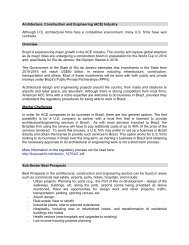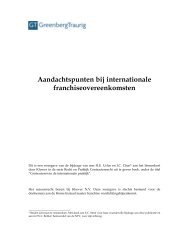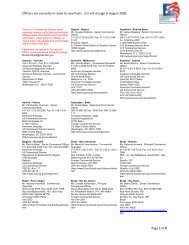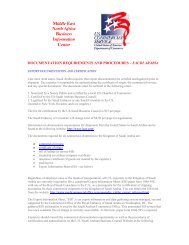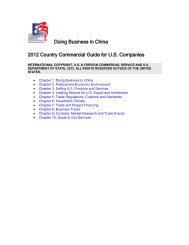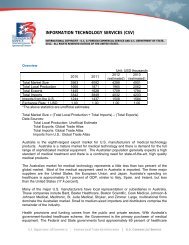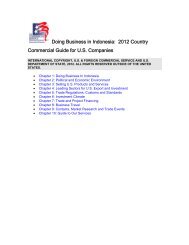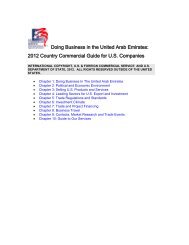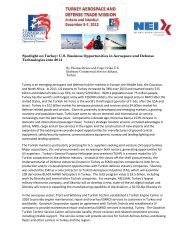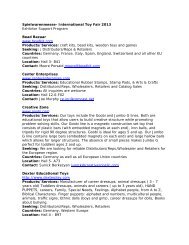Healthcare Technologies Resource Guide - Export.gov
Healthcare Technologies Resource Guide - Export.gov
Healthcare Technologies Resource Guide - Export.gov
You also want an ePaper? Increase the reach of your titles
YUMPU automatically turns print PDFs into web optimized ePapers that Google loves.
Classification<br />
Manufacturers should note that the differences in regulatory approach between the EU and the U.S.<br />
mean differences in classification and compliance verification. It would be wrong to assume that meeting<br />
the requirements for the U.S. market would satisfy the EU requirements. To illustrate this point, hospital<br />
beds including accessories, according to FDA guidance, are either Class I or II depending on the type of<br />
bed. In the EU, hospital beds and accessories are classified as Class I devices, allowing self-certification. In<br />
addition, the beds and their accessories would have to be considered separately, each as medical devices<br />
in their own right, especially when such items are sold separately.<br />
The AIMD directive has one class and does not allow self-certification. The medical device directive<br />
covers four classes, ranging from Class I, II a and b, to Class III. Only Class I devices can be self-certified.<br />
Manufacturers have to involve the services of a notified body in all other cases, and sterile Class I<br />
devices or those with a measuring function must also use a notified body. The IVD does not distinguish<br />
classes, but rather groups: general tests, self-testing kits, and Annex II lists A and B. For simple tests,<br />
self certification is usually an option. To help with classification in case the annexes in EU directives are<br />
difficult to interpret, the Commission has published new guidance at http://bit.ly/PfkVYa.<br />
Borderline Products<br />
For the majority of medical devices, the purpose is obvious: pacemakers, endoscopes, syringes and<br />
wound dressing are clearly to be used for medical purposes. Products where the intended purpose is not<br />
so clear are known as borderline products and they may be subject to several directives. For example,<br />
a scale to weigh patients in a hospital would be subject to both the non-automatic weighing scale and<br />
the medical device directives. Disinfectants for exclusive use with a medical device may be classified<br />
as an accessory to a medical device because the intended purpose is medical rather than general.<br />
The intended purpose is usually supported by appropriate statements on the company’s website or<br />
in promotional literature. It is possible to get an official interpretation to clarify borderline products<br />
but manufacturers should be able to make the determination in most cases themselves by using the<br />
guidance provided by the Commission.<br />
The Commission released new guidance on borderline products in March 2011: bit.ly/QExPo6.<br />
Compliance with “Essential Requirements”<br />
The “essential requirements” for the protection of health, safety and environmental concerns form<br />
the core of the directives. They cover risks and hazards that may occur at the design, production and<br />
handling stages. The manufacturer has to address the essential requirements which apply to a product<br />
and identify relevant risks for the patient. Non-relevant essential requirements do not have to be<br />
considered. As an example, manufacturers of arm braces made of stretch fabric would have to consider<br />
the essential requirements related to “compatibility between the materials used and biological tissues,”<br />
in other words, the fabric’s potential to cause skin allergies. A non-relevant requirement for arm braces<br />
would be “protection against radiation.” Choice of packaging is an essential requirement for prepackaged<br />
devices, as damage resulting from mishandling could have an adverse impact on the device making it<br />
harmful for the patient upon use. These are just examples, bearing in mind that there are many other<br />
elements to verify and that the manufacturer should carefully review the complete list of essential<br />
requirements.<br />
Use of EU-Wide Harmonized Standards<br />
The task of complying with essential requirements can be simplified by voluntarily using EU (EN)<br />
harmonized standards. The risk assessment management standard which facilitates the initial checking<br />
of the relevant essential requirements is ISO/EN 14971. Manufacturers may also establish their own<br />
checklists for risk assessment of medical devices.<br />
U.S. Commercial Service <strong>Healthcare</strong> <strong>Technologies</strong> <strong>Resource</strong> <strong>Guide</strong> | 2012–2013<br />
33



